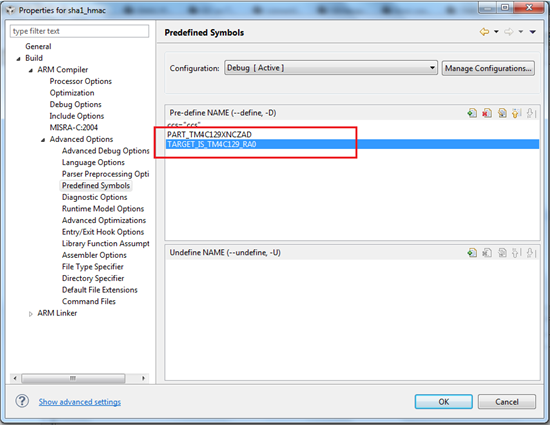Hello,
We are working on a customized TIVA board. The TIVA is connecting via ICE and Etherent , UART1 are working OK.
The attached code was created by PinMux utility in order to initialize I2C5,7
But when we sent data via I2C5 (and 7) we saw nothing with scope. No clock and no data
Can you tell what are we doing wrong ?
What should we check using scope or code ?
We used the same code on TI's TIVA board. In this board we used I2C6 only.
Best regards,
Z.V
//*****************************************************************************
// Copyright (c) 2014 Texas Instruments Incorporated. All rights reserved.
// Software License Agreement
//
// Redistribution and use in source and binary forms, with or without
// modification, are permitted provided that the following conditions
// are met:
//
// Redistributions of source code must retain the above copyright
// notice, this list of conditions and the following disclaimer.
//
// Redistributions in binary form must reproduce the above copyright
// notice, this list of conditions and the following disclaimer in the
// documentation and/or other materials provided with the
// distribution.
//
// Neither the name of Texas Instruments Incorporated nor the names of
// its contributors may be used to endorse or promote products derived
// from this software without specific prior written permission.
//
// THIS SOFTWARE IS PROVIDED BY THE COPYRIGHT HOLDERS AND CONTRIBUTORS
// "AS IS" AND ANY EXPRESS OR IMPLIED WARRANTIES, INCLUDING, BUT NOT
// LIMITED TO, THE IMPLIED WARRANTIES OF MERCHANTABILITY AND FITNESS FOR
// A PARTICULAR PURPOSE ARE DISCLAIMED. IN NO EVENT SHALL THE COPYRIGHT
// OWNER OR CONTRIBUTORS BE LIABLE FOR ANY DIRECT, INDIRECT, INCIDENTAL,
// SPECIAL, EXEMPLARY, OR CONSEQUENTIAL DAMAGES (INCLUDING, BUT NOT
// LIMITED TO, PROCUREMENT OF SUBSTITUTE GOODS OR SERVICES; LOSS OF USE,
// DATA, OR PROFITS; OR BUSINESS INTERRUPTION) HOWEVER CAUSED AND ON ANY
// THEORY OF LIABILITY, WHETHER IN CONTRACT, STRICT LIABILITY, OR TORT
// (INCLUDING NEGLIGENCE OR OTHERWISE) ARISING IN ANY WAY OUT OF THE USE
// OF THIS SOFTWARE, EVEN IF ADVISED OF THE POSSIBILITY OF SUCH DAMAGE.
//
// This file was automatically generated by the Tiva C Series PinMux Utility
// Version: 1.0.4
//
//*****************************************************************************
#include <stdint.h>
#include <stdbool.h>
#include "Tiva.h"
#include "inc/hw_types.h"
#include "inc/hw_memmap.h"
#include "inc/hw_gpio.h"
#include "driverlib/sysctl.h"
#include "driverlib/pin_map.h"
#include "driverlib/rom_map.h"
#include "driverlib/gpio.h"
//*****************************************************************************
void
PortFunctionInit(void)
{
//
// Enable Peripheral Clocks
//
MAP_SysCtlPeripheralEnable(SYSCTL_PERIPH_I2C7);
MAP_SysCtlPeripheralEnable(SYSCTL_PERIPH_I2C5);
MAP_SysCtlPeripheralEnable(SYSCTL_PERIPH_GPIOA);
MAP_SysCtlPeripheralEnable(SYSCTL_PERIPH_GPIOB);
//
// Enable pin PB4 for I2C5 I2C5SCL
//
MAP_GPIOPinConfigure(GPIO_PB4_I2C5SCL);
MAP_GPIOPinTypeI2CSCL(GPIO_PORTB_BASE, GPIO_PIN_4);
//
// Enable pin PB5 for I2C5 I2C5SDA
//
MAP_GPIOPinConfigure(GPIO_PB5_I2C5SDA);
MAP_GPIOPinTypeI2C(GPIO_PORTB_BASE, GPIO_PIN_5);
//
// Enable pin PA4 for I2C7 I2C7SCL
//
MAP_GPIOPinConfigure(GPIO_PA4_I2C7SCL);
MAP_GPIOPinTypeI2CSCL(GPIO_PORTA_BASE, GPIO_PIN_4);
//
// Enable pin PA5 for I2C7 I2C7SDA
//
MAP_GPIOPinConfigure(GPIO_PA5_I2C7SDA);
MAP_GPIOPinTypeI2C(GPIO_PORTA_BASE, GPIO_PIN_5);
}


